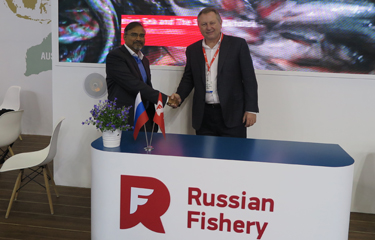Moscow, Russia-based Russian Fishery Company (RFC) will be an active bidder in the upcoming auction for cod and haddock quotas, the company has said.
Russia’s Federal Agency for Fisheries is auctioning the quota. To qualify, companies must invest in infrastructure upgrades in the form of either vessel or processing plant upgrades. The Interdepartmental Commission of the Ministry of Agriculture of the Russian Federation and the Federal Agency for Fisheries approved RFC’s application, which detailed its planned construction of four vessels and a coastal plant in the Northern Fishery Basin with daily capacity of 25 metric tons, the company said in a statement.
The quotas were introduced by the Russian government in 2016 to spur domestic investment, with the specific objective of pushing companies to upgrade their fleets and build enough processing capacities to reduce dependence on imports and produce more value-added seafood products in the country. The program reserves 20 percent of a quota for species over a 10- to 15-year period for companies that have new ships built at Russian shipyards or build plants in Russia.
Two application campaigns were conducted in 2018 and 2019, bringing in total investments of RUB 110 billion (USD 1.7 billion, EUR 1.52 billion) into the construction of 33 vessels and RUB 22 billion (USD 340 million, EUR 304.8 million) for 21 plants, the Federal Agency for Fisheries said. These results will allow for renewal of 60 to 65 percent of fleet in the Northern Fishery Basin and 25 to 30 percent of fleet deployed in the Far Eastern Fishery Basin, two largest fishery basins in Russia, which together generate more than 90 percent of the Russia’s total catch.
RFC also participated in two earlier phases of the program, which saw them commit to building six 108-meter super-trawlers equipped with state-of-the-art equipment, allowing for processing fish at sea into value-added products (primarily fillet and surimi), and the construction of one coastal plant. Two first super-trawlers with annual capacity of 50,000 MT, are scheduled to start operations in 2020. The plant, under construction in the Murmansk region, is scheduled to be completed in September and will have a daily processing capacity of 50 MT of cod and haddock. Main equipment assembly is currently ongoing on the site.
The number of bids for the third application campaign exceeded the quotas available, and to resolve the situation, the Federal Agency for Fisheries will conduct a Dutch auction.
As part of its application for the auction, RFC announced plans to purchase four vessels similar to those it previously ordered over the past two years. The vessels will be built by the Admiralty Shipyard in St. Petersburg, though the order is contingent upon the volume of quota that the RFC wins at auction, the company said.
The company also announced Murmansk as the location of the new processing plant, which will focus on cod and haddock. The project will be implemented in partnership with the Agama Group, the leading Russian manufacturer of fish products, which is a partner of RFC in the first plant it built to take advantage of the government incentive program. The second plant’s daily capacity will be at least 25 MT of fillet of cod and haddock.
“The RFC is focused on active and long-term development,” RFC CEO Fedor Kirsanov said in a press release. “As part of the investment quota program, we are building six super-trawlers and two fish processing plants. RFC will have a fleet of a new level of efficiency and safety and will provide the possibility of processing up to 100 percent of the catch into high-value-added products.”
In a separate announcement at the 2019 Seafood Expo Global in Brussels, Belgium on 8 May, RFC said it would begin “directing attention for Pacific herring sales to Nigeria and other parts of Africa.”
“Traditionally, China was our main export market for Pacific herring. But Africa promises to catch up on volume sales in the coming few years,” Kirsanov said. “Currently RFC is focused mainly on Nigeria, but we plan to expand our presence in the African market as we believe, that demand for pelagic species in Africa will increase in [the] future.”
Last year, RFC sold around 10,000 metric tons of Pacific herring in Nigeria through the Africa-based Stallion Group. RFC and Stallion Group representatives “discussed the prospects for further cooperation” during the expo in Brussels, the companies said in a press release.
“Russian Fishery Company is a reliable partner and we are looking forward to develop our partnership further,” Stallion Group Executive Director Jeykumar Ponraj said. “We are going to explore further beyond Nigeria in the region like Cote d’Ivoire and Ghana.”







